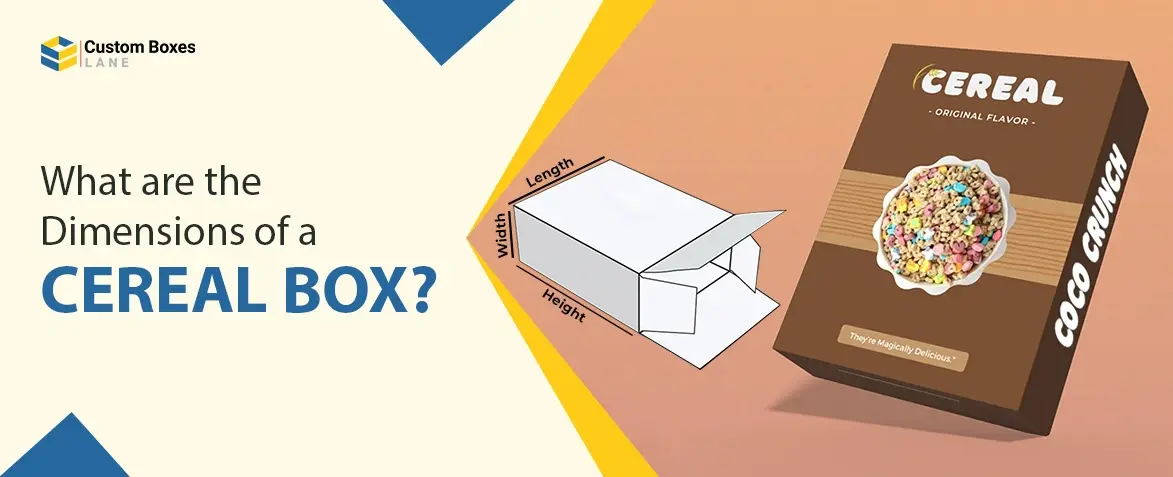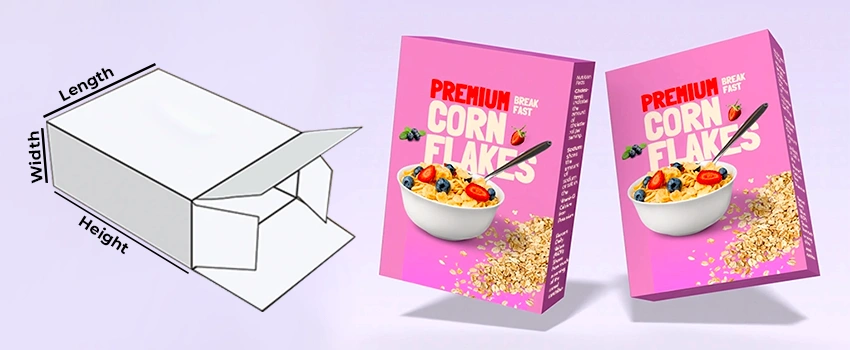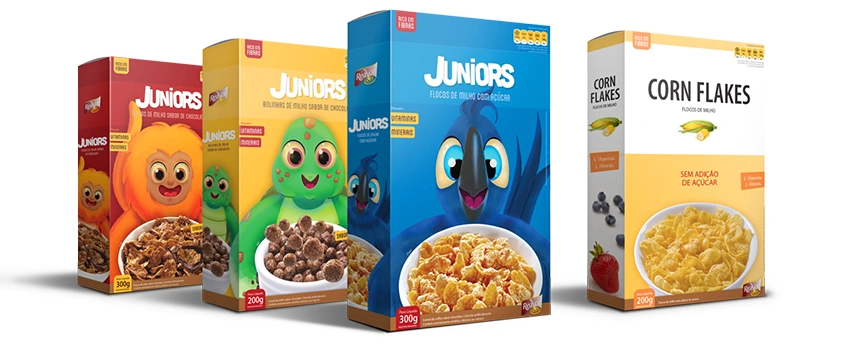What Are the Dimensions of a Cereal Box?
2024-07-18 13:30:50

What are the Dimensions of a Cereal Box?
One of the many reasons food industries go for custom packaging is to choose the dimensions as per their product’s size and weight. These custom dimensions keep the product safe in transportation and on the shelf.
Custom packaging not only helps in creating a brand identity but also keeps the products safe. Let’s have a look at the dimensions of a cereal box and how to customize your boxes to attract customers.

Why Dimensions are Important in Packaging?
Dimensions help in keeping the product safe within the packaging. Cereal boxes come in a variety of sizes as per the cereal’s quantity. Whether streamlining cereal logistics or showcasing suitably in retail stores, the significance of cereal box dimensions is undeniable.
These three metrics can help you determine whether or not your cereal will fit in the box without getting crushed. It helps you stack the calculated number of boxes on the retail shelves and cover the maximal space without hassle.
Height
To decide how tall is a box of cereal you have to look at certain factors. These factors are the weight of your cereal and the length of the box. Generally, the height ranges between 10 to 12 inches. However, you can customize the height of your cereal box as per your brand’s needs.
Length
Generally, the average length used for cereal boxes is around 8 inches. The length depends on the height of the cereal box. So, if your box is around 12 inches in height, the perfect length will be 8 inches. The dimensions should align to keep the cereal safe from getting crushed.
Width
How wide you will be making your cereal box depends on the quantity of your cereal. The wider the cereal box is, the more room the cereal gets from getting crushed. Generally, cereal boxes are 1.75 to 2 inches wide. The width can be adjusted in accordance with the length.
Other Factors to Keep in Mind When Customizing

While the above-mentioned dimensions are important, there are other factors you should keep in mind when customizing your cereal boxes. Some of these factors are dependent on the dimensions of the cereal box. These factors are:
Volume of the Box
The volume of a cereal box depends on the length, width, and height of the box. Here, the average length will be the same as the depth of the cereal box which is 2”. Therefore, the volume of a cereal box will be 192 cubic inches.
Thickness of the Box
To answer how thick is a box of cereal you have to look at the material you are using for the box. The thickness of the material will determine the safety of your cereal. The average thickness of a cereal box is 0.022 inches.
Weight of the Box
To answer the question of how much does an average box of cereal weigh, you have to look at the weight of the box combined with that of the cereal. The average weight of a cereal box is 17.5 ounces equivalent to 500 grams.
How to Choose the Right Box Size for Your Cereal Packaging?
Choosing the right box size depends on a lot of factors. Keeping in mind your consumer’s needs can help you in choosing the right dimensions of your packaging boxes. However, that’s not all as there are other certain aspects you must keep in mind. These are:
Understanding Target Audience
Consumer behavior is an important factor in choosing the right cereal box. Divide your target audience into two main groups:
- Single or Small Households
- Large Families
Small households or single people may prefer smaller portions while large families may prefer buying family-sized boxes. Similarly, some people prefer buying cardboard boxes while others look for mylar bag packaging for the cereal boxes.
To facilitate a large number of consumers, you can come with different styles, sizes, and packaging materials for your cereal.
Estimating Transportation
If you want your product to reach the consumers safely, you need to ensure safe transportation. A safe option is to keep some space between the cereal and the box so that even when the box is compressed, the cereal remains safe.
Most brands add primary and secondary packaging around their cereal for the same reason of keeping the cereal box safe. It protects the cereal from external damage.
Considering the Shelf Display
Keeping in mind the size of the shelves helps in determining the right dimensions of the box. If you are only selling the cereal from your stores, it won’t be hard. But if you are going for retail, researching the market can help you get the average number.
Some shelves can accommodate the 12” height of the box while others cannot. Similarly, the length and width of one box decide the total number of boxes on one shelf.
Deciding Your Cereal’s Quantity
Decide the quantity of cereal you want to put inside the boxes. People often question the average size of a cereal box. The box’s size depends on the brand’s choice of using a certain quantity of cereal. Make different sizes of boxes as per the cereal quantities you offer.
You can use three standard sizes for your cereal boxes for small, medium and large quantities. However, it is not an exception as you can have more or less sizes.
What are the FDA Principal Display Panel Guidelines?
The principal display panel applies to the packed food used for labeling to be displayed on the retail shelves. If you want to catch your consumer’s attention, following the PDP guidelines is a must.
According to the FDA 40% of the box area is considered a principal display panel where the following information must be mentioned:
Statement of Identity/ Name of the Food
Also known as the name of the food, the statement of identity is the first thing that you should add to your cereal box.
Brand Name
The brand name is usually placed above the name of the food in smaller font sizes. However, it is not an ironclad rule.
Net Quantity
The amount of cereal your packaging contains should be written on the display box in grams. It helps consumers make the right decision.
Nutrition and Health Claims/ Facts
Using health and nutrition claims on your cereal box can help the consumer in buying the product. These claims signify the nutritional value of the cereal.
Choose the Suitable Material
There are different types of packaging material you can use for your cereal boxes. It is important to note that you must pack cereal in primary packaging, like paper or plastic bags and then add secondary packaging. Some of these material types are:
Cardboard
Cardboard is thicker than paperboard and thus keeps the cereal safe in transportation and on the shelf. Cardboard provides better protection against external factors, like moisture, pressure, etc., as compared to paperboard. They are eco-friendly.
Kraft
Kraft boxes are sturdier than cardboard as they are made up of multiple layers of kraft paper pressed together. These boxes keep the cereal safe during transportation and act as a good barrier against pressure. Kraft boxes are eco-friendly.
Mylar Bags
There are many reasons for choosing mylar bags for packaging. They have great tensile strength as they are made from PET. With mylar bags, you don’t have to worry about adding primary packaging as these bags are water, moisture, light, and heatproof.
Test the Functionality of Your Packaging
Once the packaging is manufactured according to the product measurements, you should test it before final approval for displaying it on retail shelves. This approach will help you know about the improvements for your cereal packaging as well as prevent any mishap that can ruin your brand image in the market.
For instance, using mylar bags instead of kraft can keep the cereal safe as the Polyethylene Terephthalate acts as a string barrier against air, moisture, and light. However, using kraft and cardboard allows you to be an eco-friendly brand.
Customize Your Cereal Packaging
Customizing the cereal packaging can help your brand in creating a unique identity. From choosing the right colors to style and designs, you can make your packaging stand out in the market. Following are some ways to customize your packaging:
Pick the Right Colors
There are many colors that you can try for your cereal packaging. You can use a combination of colors or not as per your liking.
Go for the Perfect Designs
Whether you want your packaging to be simple or not, depends on the designs you pick. Minimalism and maximalism are two options.
Use Different Styles
You can either go for handles or window boxes according to the consumer’s choice. Moreover, you can also use pouches for your cereal.
Try Different Finishes
Finishes can help you highlight important sections of your packaging. Embossing, debossing, matte, and gloss are some famous finishes.
Customize Your Cereal Packaging Today
You should always make a plan before customizing a cereal box in different sizes as it helps in keeping your cereal safe while creating a unique brand identity.
From determining your target audience to practically applying height, width, length, volume, and thickness on the cereal boxes, you can make functional and aesthetical cereal packaging.
Custom Boxes Lane offers its customers several benefits. You can start from as low as 100 boxes to check our quality and services. And we offer free delivery nationwide alongside free graphic design services.
So, drop us an email and we will get back to you as soon as possible!

